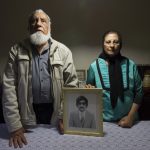Neil Aggett’s death cell revisited
Judge MA Makume has inspected the cellblock at John Vorster Square in which anti-apartheid activist Neil Aggett died. His family watched as his apparent suicide was reenacted.
Author:
22 January 2020

“Measures to reduce civil claims around Johannesburg Central” read the notice on the board next to the charge office, outside the holding cells on the second floor of the cellblock. “Respect the rights of prisoners and treat them with respect … Let us not abuse the power invested on [sic] us” it continued. These sentiments are a far cry from the attitudes displayed by the apartheid Security Branch officers in 1982, when Neil Aggett and several of his associates were detained here in the wing reserved for political detainees.
During an in loco inspection of the cellblock, Judge MA Makume and the legal teams for the Aggett families, the National Prosecuting Authority and members of the former Security Branch were shown into the 28m² cell B15 of Johannesburg Central Police Station, which in 1982 was cell 209 of John Vorster Square. This is the place where Aggett’s body was found hanging from the bars of the door in the early hours of 5 February of that year, 70 days after his arrest.
These days, the bars of the cells are covered in plexiglass to prevent prisoners from attempting to use them for suicide, and the graffiti on the walls speaks not of the struggle against apartheid but rather the plight of migrants calling for an “Africa without borders. No deportation” and declaring that “Cyril Ramaphosa is a sellout working for WC Monopoly!” Today, many of those detained here are undocumented African migrants, waiting to be deported or sent to the Lindela Repatriation Centre to the west of the city.
Related article:
Situated in the east wing of the police complex, the cells back on to the M1S highway flyover and if you’re tall enough, you can peer through a crack in the window and glimpse the gridlocked traffic heading towards the south of the city. In cell B18 a few doors down, the grills are not covered by plexiglass and so the judge, the legal teams and the accompanying media entourage make their way there for a macabre demonstration.
Reenactment
Aggett was found hanging from a noose made from a kikoi his friend Yvette Breytenbach had given him when she visited during his interrogation. Using a photograph of the lifeless Aggett hanging from the bars of his cell, the family’s lawyers, led by advocate Howard Varney, set about the grim business of showing Makume the likelihood of the 1.82m-tall Aggett tying a makeshift noose 2.6m above the floor and using it to end his life.
A volunteer of similar height is sought and as he climbs on to the lower bars of the cell door to make his noose, he puts his neck in it for a moment. This leads to a shout of “that’s enough” from Stephen Aggett, Neil’s nephew, who rushes forward to grab hold of the volunteer and stop this necessary but difficult to watch reenactment of the last moments of his uncle’s life.
Related article:
In the corner of the cell, Stephen’s aunt, Aggett’s sister Jill Berger, has turned her head away from the commotion. She is staring at the wall and trying to keep her composure after what has no doubt been a long and difficult day rewalking her brother’s last 70 days, spent in these cells up on the 10th floor of the building’s west wing. This is the former home of the Security Branch, who answered to no one and were given free rein to fight the “total onslaught” of communism and opposition to the regime by whatever means necessary.
Former detainee Jabu Ngwenya, who was detained during the same period as Aggett and will testify in the reopened inquest into his death next month, is the tallest man in the cell. Bending down, he shows Makume how he could look through the hole in the cell door and see who was being brought down the corridor.
Ngwenya’s former cell a few metres around the corner from Aggett’s was a smaller 16m² affair, possibly displaying the fact that even here – where anti-apartheid activists were brought to keep them away from God-fearing, white is right, apartheid society – the discrepancies between white and black outside the walls continued to be applied within them.
Witnesses to interrogation
The brutalist, maze-like structure of the 10th floor confounds easy navigation as sections of the building were intentionally cut off from accessing the former domain of the Security Branch. Earlier in the day, Ngwenya and fellow former detainee Maurice Smithers showed the judge where they had been on this floor when they last saw Aggett alive.
Smithers was waiting in a 10th-floor office, on his way to the optometrist, when through the frosted glass dividing room 1011 from room 1012, he saw Aggett being interrogated in the next room. He remembers that Aggett seemed to be forced to strip, made to do push-ups, was hit on the head with a rolled up newspaper and was sweating from the exertion, often wiping his brow.
Ngwenya saw Aggett undergoing what he has described as a brutal interrogation through the door of the office, across the hall from where he was being questioned.
Related article:
One thing those who on Tuesday walked the corridors of the 10th floor and the second-floor cells of what was once John Vorster Square should take away from the experience is that this was no ordinary police station, and it was never meant to be. It was built for the execution of inhumane deeds by the Security Branch, far from the prying eyes of the public and other members of the police service. It was designed to allow the branch members to perch themselves above the western edge of the city – a stone’s throw from Ferreira’s Camp, the original site of the mining settlement that became Johannesburg – in their brutalist Eye of Sauron, scanning the horizon for enemies of the state and bringing them here to deal with as they saw fit.
Either the security police killed Aggett directly by dragging his unconscious body to his cell and staging his hanging. Or they killed him indirectly through unrelenting and interminable interrogation, driving him to tie that kikoi to the bars of his cell, 2.6m above the floor, and bring an end to his torment.
While she may not have been able to take the trauma of the reenactment of her brother’s final hours in cell 209 on Tuesday, Berger will bring his life as a brother, a son and a man back to empathetic and heartbreaking life today when she takes the stand in the Johannesburg high court to tell his story and relate the Aggett family’s long struggle for justice.
None of this will be easy. But it’s a necessary and urgent part of the resurrection required to finally lay Aggett’s spirit to rest.



